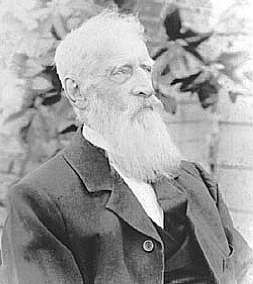Lawnton
Until the coming of the North Coast Railway in 1888, the locality now known as Lawnton was considered to be part of the North Pine district. Closer settlement of this area dated from 1862 when country farm allotments along the North Pine River were surveyed and first put up for sale. A newspaper report in 1931 on "Lawnton's noted dairy farms" stated that:
- Seventy years ago Lawnton was dense scrub, from which valuable timbers were obtained. Later, when the scrub was cleared, mixed farming was taken up, with much of the land being of exceptional fertility, owing to periodic floodings by the Pine River... [Brisbane Courier, 22 August 1931, p.9.]
The first farmers grew a variety of crops, but later farmers specialised in dairying and pig raising and cultivated lucerne, maize, wheat and cow cane as fodder crops. From 1888 until the 1930s, when road transport took over, large quantities of fresh milk were railed to Brisbane from the Lawnton Railway Station.

Stephen Lawn (1836-1917) was a farmer, blacksmith and wheelwright in the North Pine/Lawnton area during the late 19th century. Lawn migrated to Queensland from Helmsley, Yorkshire, England, in 1862 and selected land north of the North Pine River in partnership with John Atkinson Thompson. As Lawn was a blacksmith by trade, he put up a small smithy so that he could supplement his income from farming by obtaining work from other settlers. The extra traffic brought about by the Gympie goldrush provided sufficient business to enable him to concentrate on blacksmithing full-time. In 1873, he bought better land south of the River and moved his business to the new site located near today's Lawnton Tavern. As some of this land was acquired for the construction of the North Coast Railway in 1887, the Lawnton Railway Station and the surrounding district were named in his honour.
An important local industry, first known as the Lawnton Cornflour and Starch Mills, was established in 1898 by Walter Francis. This landmark complex of buildings stood for more than 90 years on land bounded by Four Mile Creek and Gympie Road (near present day Paisley Avenue). Walter's sons, Herbert Stephen Francis and Harold Walter Francis, operated the business for some years in partnership with Robert Joyce who was familiar with the process of extracting cornflour from maize. Maize was bought from farmers in surrounding districts and railed from further afield to the Lawnton Railway Station. Water for the mill came from nearby Four Mile Creek; Walter Francis had tested the water in creeks around Brisbane and found that the purest water came from the Four Mile Creek. By the late 1920s, the mill was producing between three and four tons of cornflour every week. The name 'Paisley', under which the cornflour was marketed, came from the town of Paisley near Glasgow (Scotland) which had a very large cornflour mill. A third generation of the family, James Walter Francis and his brother William Herbert Francis, took over the operation of the mill and carried on producing cornflour and starch until the business closed down in the 1960s.
The Queensland Acclimatisation Society, first formed in 1862, moved its operations from Bowen Hills to 100 acres (40 hectares) of land on the south bank of the North Pine River at Lawnton in 1905. The Society had been established to facilitate the development of Queensland agriculture by importing, acclimatising and domesticating overseas animals and plants. By the end of 1908, sugarcane, pineapples, papaws, cotton, raspberries, date palms, mangoes, olives, sweet potatoes, citrus trees and cassava, as well as various fibres and grasses, were being trialled on the Lawnton property. Over one hundred other plants were being grown in bush and glasshouses. In later years, particular success was achieved with avocados, custard apples, pecan nuts and soya beans. By the late 1930s, as the land in the Lawnton area had been worked out as a consequence of several decades of very successful activity, the Society decided to move its operations to Redland Bay. Not long after this, however, the Society voluntarily went out out of existence because it was considered that the C.S.I.R.O. and the Queensland Department of Agriculture and Stock were better equipped to make further contributions to agricultural knowledge.
By the late 1960s, Brisbane newspapers were reporting that developers were rapidly subdividing farms in the Lawnton area into residential lots to cater for the suburban housing boom that had encroached upon the area. By 1969, the population passed the 2,000 mark. Only a few years later, by 1973, this figure had grown to nearly 5,000.
